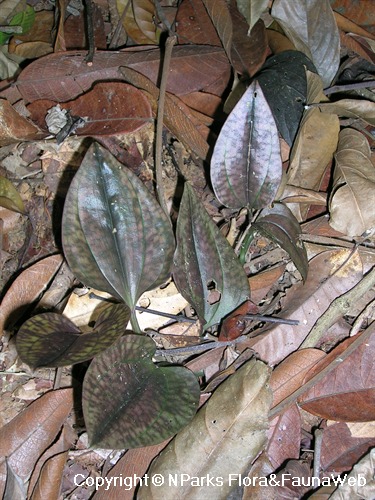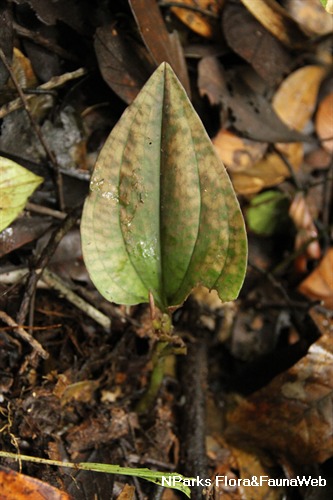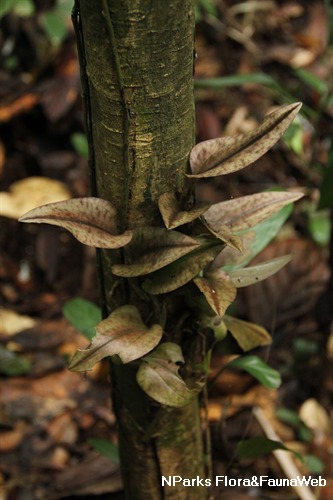
Name
Classifications and Characteristics
| Plant Growth Form | Climber, Creeper |
|---|---|
| Mode of Nutrition | Autotrophic |
Biogeography
| Native Distribution | Myanmar, Cambodia, Vietnam, Thailand, South to Peninsular Malaysia, Singapore, Sumatra, Java and Borneo. |
|---|---|
| Native Habitat | Terrestrial |
| Local Conservation Status | Native to Singapore (Critically Endangered (CR)) |
Description and Ethnobotany
| Growth Form | A terrestrial herb, it creeps or climbs via its fleshy rhizomes. |
|---|---|
| Foliage | The pseudobulbs are slender and curved, dull purple and measure about 2 to 3cm long. The leaves are triangular-ovate in shape with a cordate base and a acuminate apex and are yellow-green with dark blotches and a purple underside. |
| Flowers | The flowers are borne on a raceme which forms at the tip of new pseudobulbs. Flowers vary from almost white to pink and are non-resupinate. The flower sepals and petals are linear and acute. The flower lip is upright and ovate with an entire margin with 5 longitudinal rows of fine yellow hairs which taper into 3 ridges near the lip apex. |
| Cultivation | The plant has a climbing growth form when growing in moist areas. It is best grown under partial to full shade, in moist soil. |
Landscaping Features
| Desirable Plant Features | Ornamental Foliage, Ornamental Form |
|---|---|
| Landscape Uses | Parks & Gardens |
| Thematic Landscaping | Naturalistic Garden |
Plant Care and Propagation
| Light Preference | Semi-Shade, Full Shade |
|---|---|
| Water Preference | Lots of Water |
| Rootzone Tolerance | Moist Soils |
| Propagation Method | Seed |
Foliar
| Mature Foliage Colour(s) | Purple, Brown |
|---|---|
| Leaf Area Index (LAI) for Green Plot Ratio | 3.5 (Shrub & Groundcover - Monocot) |
Floral (Angiosperm)
| Flower & Plant Sexuality | Bisexual Flowers |
| Flower Colour(s) | Cream / Off-White, Pink |
|---|---|
| Flower Grouping | Cluster / Inflorescence |
Image Repository
Others
| Master ID | 968 |
|---|---|
| Species ID | 2262 |
| Flora Disclaimer | The information in this website has been compiled from reliable sources, such as reference works on medicinal plants. It is not a substitute for medical advice or treatment and NParks does not purport to provide any medical advice. Readers should always consult his/her physician before using or consuming a plant for medicinal purposes. |


